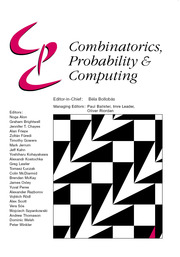No CrossRef data available.
Article contents
On the size of temporal cliques in subcritical random temporal graphs
Published online by Cambridge University Press: 26 June 2025
Abstract
A random temporal graph is an Erdős-Rényi random graph  $G(n,p)$, together with a random ordering of its edges. A path in the graph is called increasing if the edges on the path appear in increasing order. A set
$G(n,p)$, together with a random ordering of its edges. A path in the graph is called increasing if the edges on the path appear in increasing order. A set  $S$ of vertices forms a temporal clique if for all
$S$ of vertices forms a temporal clique if for all  $u,v \in S$, there is an increasing path from
$u,v \in S$, there is an increasing path from  $u$ to
$u$ to  $v$. Becker, Casteigts, Crescenzi, Kodric, Renken, Raskin and Zamaraev [(2023) Giant components in random temporal graphs. arXiv,2205.14888] proved that if
$v$. Becker, Casteigts, Crescenzi, Kodric, Renken, Raskin and Zamaraev [(2023) Giant components in random temporal graphs. arXiv,2205.14888] proved that if  $p=c\log n/n$ for
$p=c\log n/n$ for  $c\gt 1$, then, with high probability, there is a temporal clique of size
$c\gt 1$, then, with high probability, there is a temporal clique of size  $n-o(n)$. On the other hand, for
$n-o(n)$. On the other hand, for  $c\lt 1$, with high probability, the largest temporal clique is of size
$c\lt 1$, with high probability, the largest temporal clique is of size  $o(n)$. In this note, we improve the latter bound by showing that, for
$o(n)$. In this note, we improve the latter bound by showing that, for  $c\lt 1$, the largest temporal clique is of constant size with high probability.
$c\lt 1$, the largest temporal clique is of constant size with high probability.
Information
- Type
- Paper
- Information
- Copyright
- © The Author(s), 2025. Published by Cambridge University Press


